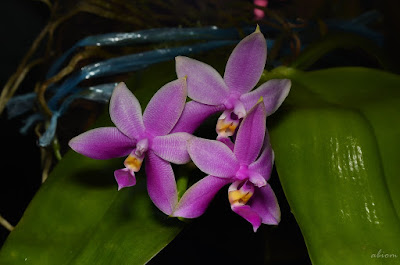Phalaenopsis violacea is endemic to the Andaman Islands, the Nicobar Islands and northwestern Sumatra. It grows as epiphyte in very moist lowland tropical forests especially along river courses at an altitude of 100-150 meters. It generally grows low down on trees and lianas, or on branches overhanging streams...
Phalaenopsis violacea also called as The Violet Phalaenopsis, Phalaenopsis violacea f. coerulea, Phalaenopsis violacea f. alba, Phalaenopsis violacea subvar. alba, Phalaenopsis violacea var. alba, Polychilos violacea, Stauritis violacea, Stauropsis violacea, is a species of the genus Phalaenopsis. This species was described by H.Witte in 1861.
IDENTIFY PHALAENOPSIS VIOLACEA
Phalaenopsis violacea is endemic to the Andaman Islands, the Nicobar Islands and northwestern Sumatra. It grows as epiphyte in very moist lowland tropical forests especially along river courses at an altitude of 100-150 meters. It generally grows low down on trees and lianas, or on branches overhanging streams.
It is a small to medium sized, hot growing, pendulous epiphyte with a very short stem carrying 3 to 4, elliptical, obtuse, undulate gradually narrowing below into the basally clasping, reach a maximum of 25 cm in length leaves.
The Violet Phalaenopsis has extremely fragrant flowers occuring in the spring that are borne one by one in succession on a pendant, stout, jointed, fractiflex, 10 to 12.5 cm long inflorescence with a flattened, zigzag rachis with 2 to 7, successive flowers with 2 to 3 open at any one time. The flower is small (3.5 cm wide), fragrant and mostly violet. Some varieties of this plant have some green color on the tepal edges.
PHALAENOPSIS VIOLACEA CARE AND CULTURE
Cultural information should only be used as a guide, and should be to be adapted to suit you. Your physical location; where you grow your plants, how much time you have to devote to their care, and many other factors, will need to be taken into account. Only then can you decide on the cultural methods that best suit you and your plants.
Light:
Phalaenopsis violacea with an average light level of 16000-19000 lux is sufficient. The photoperiod is 12 hours.
Temperature:
The ideal summer temperatures are 25-29 ° C during the day and 19-20 ° C at night, the winter ones 20-22 ° C during the day and 15-16 ° C at night.
Humidity:
The Violet Phalaenopsis needs the minimum humidity of 60% if the plant is placed in a pot, and 75% if it is placed bare-root.
Substrate, growing media and repotting:
Phalaenopsis violacea can be grown both in pots and in bare roots. The vase must be transparent to facilitate checks of the substrate and roots. The pine bark of 2-4 cm is used as a substrate. If mounted on a raft, it is important to put a layer of sphagnum under the roots of the orchid.
Watering:
This species gets water as soon as the substratum has dried almost completely but not completely. An important indication is the color of the roots: when they are dry they take on the silver-green color if they are not covered with algae. The bare root specimens get wet 1-2 times a day. It is important to remove the excess water accumulated after the wetting in the axils of the leaves and in the center of the stem: the permanence of water there causes the rot. During the warmer months, the plant benefits from vaporization, as well as watering. Vaporizations are carried out before the evening, to allow the plant to dry before the night arrives.
Fertilizer:
The plant is fertilized every 3 watering using 1/2 of the dose indicated on the vial of a special liquid fertilizer for orchids. Before fertilizing the plant it is necessary to water it: in this way the harmful effect of the fertilizer on the dry roots is avoided.
Rest period:
Phalaenopsis violacea has no rest and can bloom at any time, especially during the period from May to October. The inflorescences have the habit of lengthening and producing flowers for more seasons, so they do not cut until they turn yellow by themselves.















COMMENTS